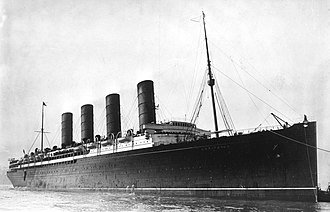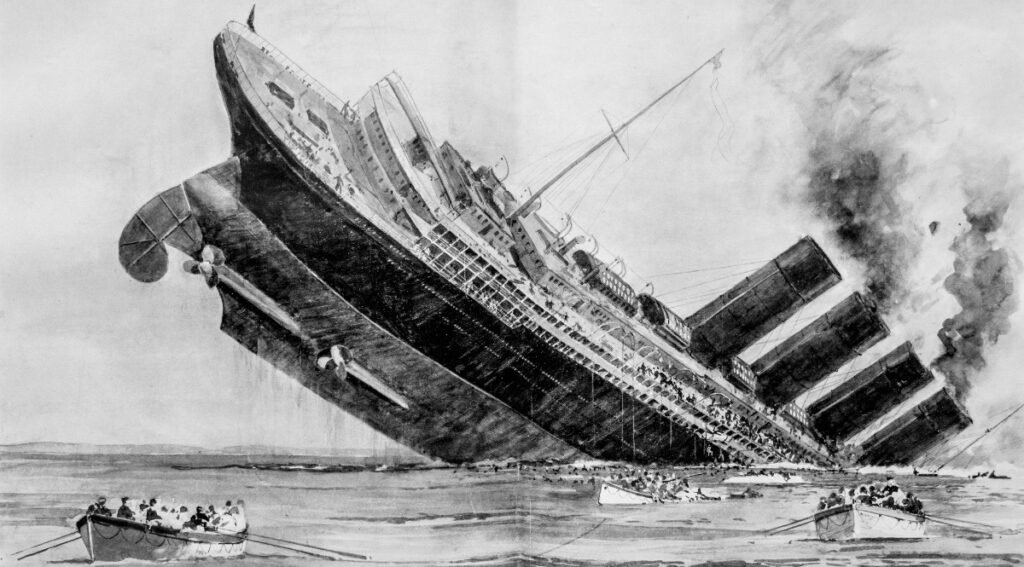
Who Was Alfred Gwynne Vanderbilt?
When people hear the name Vanderbilt, they usually think of wealth, railroads, and high society. Alfred Gwynne Vanderbilt was no exception—he was born into America’s elite in 1877 and lived a life that, on the surface, looked like it was cut straight from luxury. He was the son of Cornelius Vanderbilt II and the heir to part of the vast Vanderbilt fortune. But what most folks don’t know is that this same man—who had everything—chose to give it all up for someone he didn’t even know.
Alfred wasn’t just some spoiled heir. He had a passion for sports, especially horse-drawn coaching, and was well known in both American and British social circles. He had every reason to avoid danger, stay safe, and protect his future. But what he did in his final moments aboard the RMS Lusitania in 1915 showed that real character runs deeper than wealth or status.
His story didn’t end with boardrooms or country estates. It ended in the cold waters off the coast of Ireland, after he made a split-second choice that few people today would even imagine facing.

What Was the Lusitania and Why Was He On It?
The RMS Lusitania was one of the grandest ocean liners of its time, owned by the British Cunard Line. It was built for speed and luxury, often making the transatlantic journey between New York and Liverpool in record time. But by 1915, the world was at war—and civilian ships were no longer guaranteed safe passage.
Germany had warned that any vessel entering the war zone around the British Isles was fair game. Still, many passengers believed that a ship like the Lusitania, carrying civilians, including Americans, would never be attacked. Alfred Vanderbilt was one of those passengers. He was headed to England on business, but despite the risks, he boarded that ship with no idea that it would be his last voyage.
The Lusitania sailed on May 1, 1915. Six days later, a German U-boat launched a torpedo into its side. The explosion was fast, brutal, and unexpected. In just 18 minutes, the mighty liner was beneath the sea. Over 1,100 people died that day—including Alfred Vanderbilt.
But it’s how he died that keeps his name alive more than a century later.

What Did Alfred Vanderbilt Do in His Final Moments?
As chaos unfolded on the Lusitania, Alfred Vanderbilt was seen helping others get to safety. Survivors later testified that he remained calm, assisting women and children into lifeboats—even though he knew how limited the options were. The ship was listing so badly, lifeboats on one side couldn’t even be launched. He didn’t panic. He didn’t push his way to survival.
Instead, he did the unthinkable: Vanderbilt took off his life jacket and gave it to a young mother who had a baby in her arms. He knew he couldn’t swim. He knew there weren’t enough lifeboats left. And he gave up his only chance anyway.
That’s not something you expect from a millionaire socialite of the Gilded Age.
His body was never recovered from the sea. But the story of what he did lived on in news reports, survivor accounts, and family stories passed down through generations. It’s one of those rare moments in history where someone truly gives up everything, including their life, for a stranger.
It reminds me of other acts of selfless courage in our articles like how gas rationing worked in World War II—a time when Americans had to sacrifice comfort and convenience for the greater good.
Alfred’s actions were a quiet but powerful stand against the fear and chaos that surrounded him. He didn’t have to be there. He didn’t have to help. But he did.

Why Was Alfred Vanderbilt’s Sacrifice So Impactful?
There were a lot of deaths that day—more than a thousand lives lost in under 20 minutes. But Alfred Vanderbilt’s story hit differently. This wasn’t just another passenger. This was the Vanderbilt. A symbol of wealth, prestige, and American high society. And yet, when the moment came, none of that mattered. He was just a man who chose someone else’s life over his own.
The newspapers went wild with the story. In a time when America hadn’t yet entered World War I, his sacrifice helped shift public sentiment. People were outraged that civilians—especially Americans—were being targeted. But they were also inspired. This man, who could’ve easily done nothing, became a symbol of courage in a world teetering on the edge of full-scale global war.
What also makes this story land even harder is that he left behind a pregnant wife and a young son. He knew that. He didn’t hesitate. It was compassion over self-preservation. That kind of bravery doesn’t get forgotten.
This was the same era where we’ve written about the harsh realities of everyday life, like how laundry was done in the early 1900s and how food was kept cold before refrigerators. Life was tougher across the board. Vanderbilt’s story didn’t happen in a vacuum—it was part of a generation forced to face unthinkable challenges.
And his actions? They echo through time like a final message: when faced with crisis, character matters more than money.

What Was the RMS Lusitania and Why Did It Matter?
Before we talk more about Alfred Vanderbilt, it helps to understand the ship he was on. The RMS Lusitania wasn’t just any ocean liner—it was one of the fastest and most luxurious ships in the world. Think of it like the Titanic’s classy cousin, but even quicker. Built by the Cunard Line, it held the Blue Riband for fastest Atlantic crossing and catered to the wealthy elite… as well as everyday travelers, immigrants, and families crossing the ocean.
The Lusitania was a British ship, and during wartime (World War I had broken out in 1914), it became a controversial target. Germany had already warned that it would consider any British or Allied ship fair game—even passenger ships. The U.S. hadn’t joined the war yet, but tensions were rising. So when the Lusitania left New York for Liverpool in May of 1915, people were nervous—but no one really thought it would be sunk.
Then came May 7, 1915. A German U-boat torpedoed the ship off the coast of Ireland. It sank in just 18 minutes.
Of the 1,959 people on board, 1,198 died, including 128 Americans—one of them being Alfred Vanderbilt.
That tragedy played a massive role in swaying U.S. public opinion against Germany. While it didn’t immediately launch America into war, it was a major step in that direction. And it turned the Lusitania into more than just a shipwreck—it became a symbol.
If you liked learning about this kind of historical transportation, check out how mail delivery worked in the early 1900s—another glimpse into what life was really like around the same time Vanderbilt took his final voyage.

Who Was Alfred Gwynne Vanderbilt Before the Lusitania?
Alfred wasn’t your average guy. Born in 1877 into the ultra-rich Vanderbilt family, he inherited a massive chunk of wealth when his father, Cornelius Vanderbilt II, passed away. By his 20s, Alfred was already known as one of the richest men in America. And unlike some trust fund heirs, he didn’t just sit around sipping martinis. He managed railroads, invested in hotels, and became a serious name in international business.
But despite his wealth, Alfred was also known for being surprisingly down-to-earth. He loved sports, horses, and was deeply into coaching—think old-school carriages and teams of horses. He once took a coaching trip from London to Brighton just because he loved the experience and tradition of it.
He was also generous. Whether it was donating to schools or quietly helping people in need, Alfred wasn’t all show. In fact, his decision to board the Lusitania was partly to attend an important meeting for a YMCA initiative aimed at improving wartime support.
Alfred’s social circle was the who’s who of the early 1900s, but he wasn’t just about flashing cash. His actions during the sinking proved that.
His story pairs well with other glimpses into upper-class life from that time, like growing up in 1950s small-town America, where community values often trumped wealth. It’s wild how often these stories overlap: money might change someone’s lifestyle, but it doesn’t always change their heart.

What Happened During the Final Minutes of the Lusitania?
When the German U-boat torpedoed the RMS Lusitania on May 7, 1915, it sent shockwaves across the world. But on board, the panic was immediate and personal. Alfred Gwynne Vanderbilt, one of the richest men in America, didn’t act like a man scrambling to save himself. Instead, he calmly assessed the situation and tried to help others.
Several survivors, including his valet Ronald Denyer, later recalled Alfred’s composure during those terrifying minutes. He helped women and children into lifeboats and didn’t attempt to push his way ahead—despite knowing he couldn’t swim. His most memorable and selfless act came when he removed his own life jacket and handed it to a young mother holding her baby. He understood what that meant—he wouldn’t survive.
It’s heartbreaking, but deeply moving. Alfred was 37 years old and left behind a wife and three young children. His death was widely mourned not just because he was a Vanderbilt, but because he proved that character mattered more than status. His body was never recovered, making his story even more haunting.

The Lusitania sank in just 18 minutes. There wasn’t enough time or enough lifeboats—something that eerily echoed other tragedies of the era, including the Titanic just a few years earlier. These moments remind us how fragile early 20th-century travel really was. Even a ship full of the world’s elite wasn’t immune to disaster.
If you’ve read about how people kept food cold before refrigerators, you know that even simple tasks back then were tough. Life was harder, riskier, and often unpredictable. Alfred’s final act stands out because it was rare—and because it showed what true honor looked like in a moment when most would panic.
As an Amazon Associate we earn from qualifying purchases through some links in our articles.




